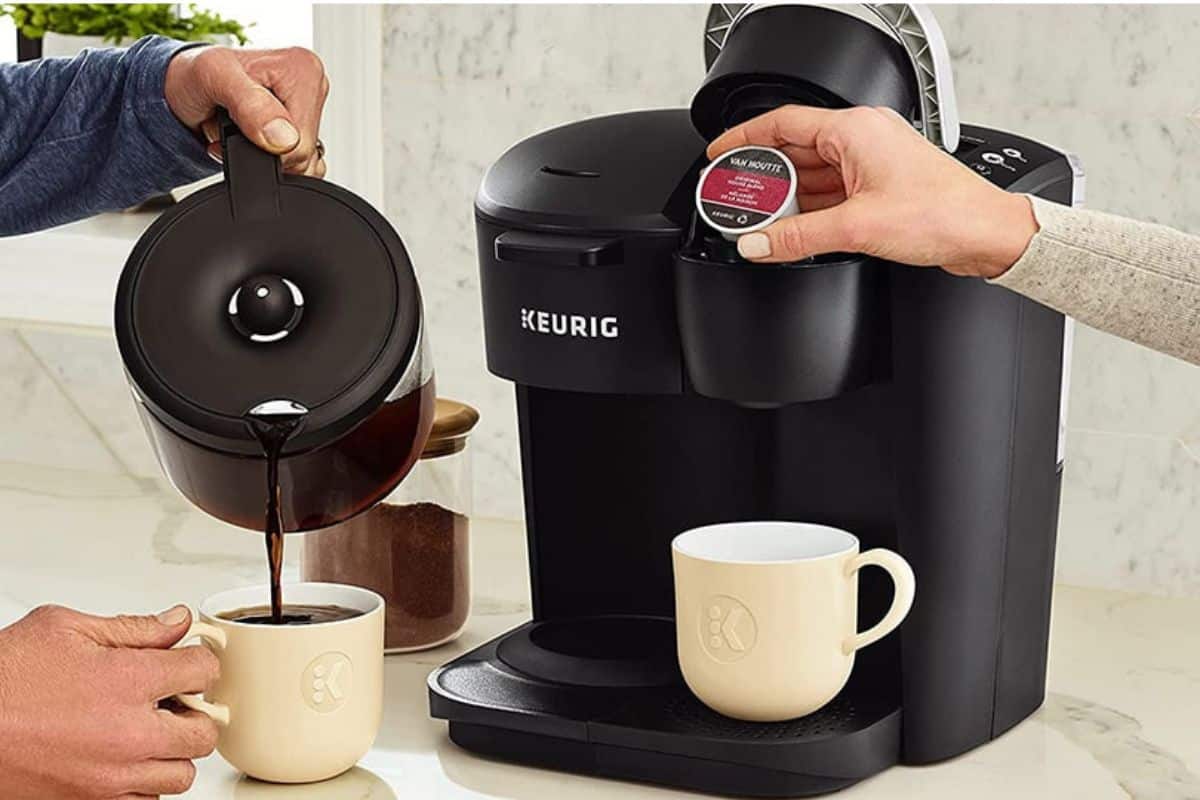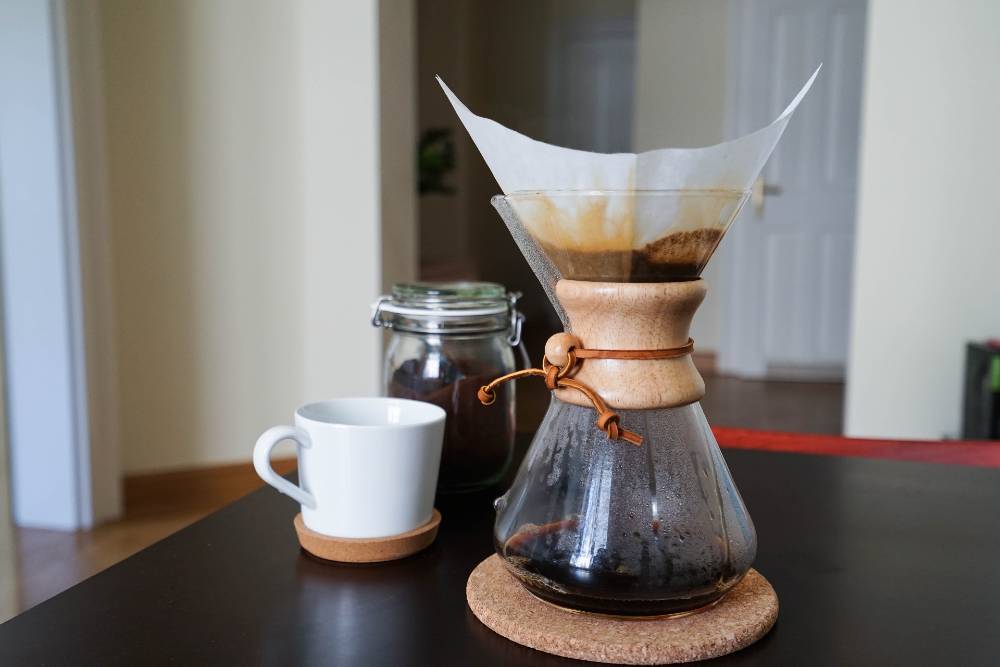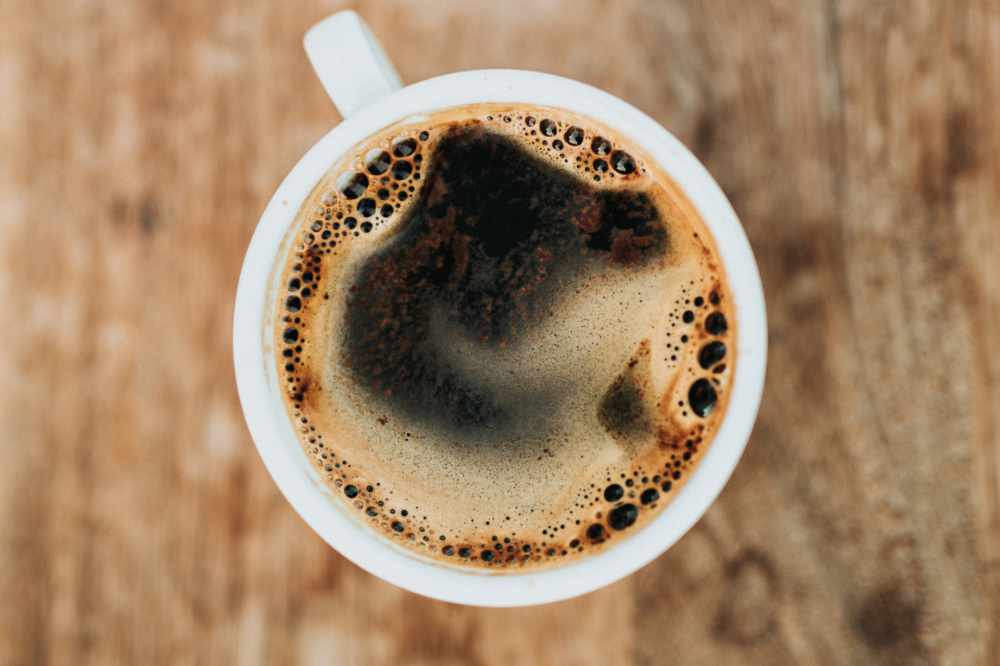Espresso is arguably one of the best ways to drink coffee. Rich, smooth, and nutty, it embodies everything we love about a cup of coffee in concentrated form. The best way to create this brew is an espresso machine that is capable of at least 9 bars of pressure. For those with an espresso machine on their kitchen counter, you are the envy of those who don’t!
If you are still saving to buy an espresso maker, you can choose to go to a local coffee shop where a barista will make a shot on command, or you can try your hand at making a home espresso. So how can you make espresso at home?
There are a few ways to copycat an espresso with the Moka pot, AeroPress, and french press. While these won’t give you that full, authentic crema, they can make an espresso-like drink that can get you close to the rich flavor of espresso. Or, you can choose a semi-automatic espresso maker, which allows you to reach 9 bars of pressure without being too tough on your budget.
Let’s get started on how to make espresso …
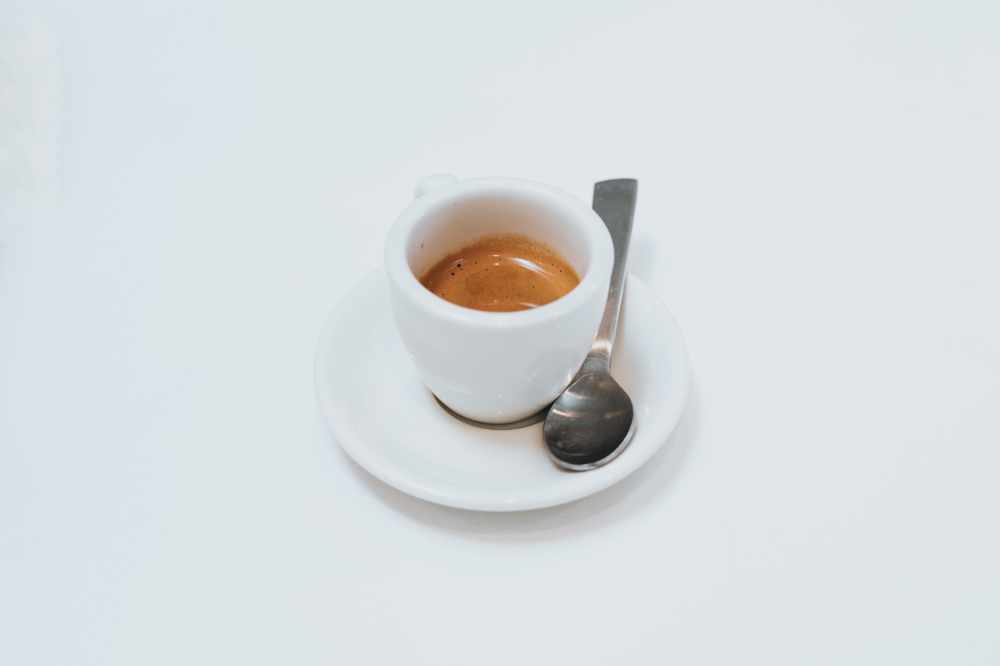
So, What Is Espresso?
So if we want to make an espresso-like coffee, let’s first look at what makes espresso different from other coffee drinks.
The Coffee Beans
The beans you choose can greatly affect the taste of your final brew with whichever method you use. Many roasters sell an “espresso roast,” which is usually a dark roast with a fine grind. As a coffee-making novice in my college days, I thought that buying this bag of coffee would magically give me the full-bodied richness and flavor of a great espresso. Trying out that theory in my drip maker, clued me in that there was a lot more to a good espresso than just espresso coffee beans.
While espresso can be made using any roast, darker roasts tend to give more body and will decrease some of the acidity naturally present in coffee beans. For the richest flavor, use a burr grinder to grind coffee fresh, and make sure you set your grind size to match your method.
Made Under Pressure
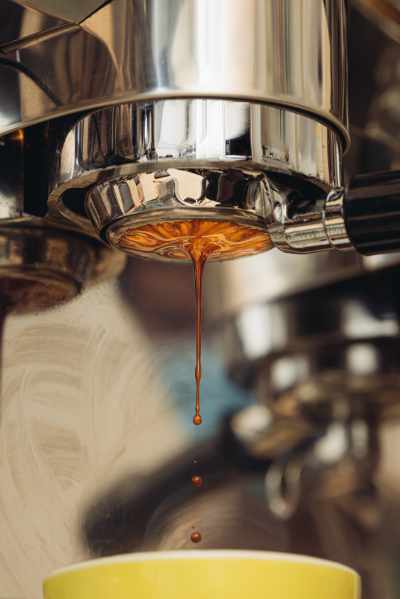
One of the main differences between espresso and your regular cup of joe is that espresso is made using pressure, whereas a regular cup of coffee flows through the grounds. When you put coffee grounds under high pressure, the result will be a stronger brew with that deliciously smooth crema on top.
To get the equivalent amount of pressure that an espresso maker achieves, you would have to be able to manually press out coffee using around 600 lbs of pressure. (I’ll stick with my 25 lb weights, thank you.) And, even if you had that kind of muscle, a regular coffee-making apparatus would likely give out before you reached your target.
Methods like the Moka pot and Aeropress can create some pressure, but it will still be considerably less than an authentic espresso. While we can use the same coffee grind and roast as an espresso, the pressure factor is what makes the espresso hard to replicate without an espresso machine.
Quick Brew Time
Espresso is considered a quick brew method. The pressure factor we mentioned cuts down on the time you need to get your coffee through the machine. This quick brewing method extracts coffee without allowing it time to also extract the more undesirable flavors. The result is a rich, flavorful brew.
The Caffeine
Espresso is a more concentrated drink and contains more caffeine if you set it side by side with the same amount of drip coffee. While there is a tendency to think that the person who chooses an espresso will be more caffeinated than the regular coffee drinker, this is not necessarily the case.
A shot of espresso contains about 63 mg of caffeine, while an 8 oz cup of regular brewed coffee contains 95 mg. So, if we compare one serving to one serving, a mug of regular brewed coffee will generally contain more caffeine than espresso.

Making an Espresso-like Coffee
Knowing how espresso is made can help us figure out what makes it taste so dang good. It also helps us make our best stab at a home espresso. The three coffee brewing methods that can copy espresso’s bold flavor best are the Moka pot, the AeroPress, and the French press.
The Moka Pot Brewing Method
The Moka pot was invented to be an espresso maker for home use, and is even known as the “stovetop espresso maker.” This tiny wonder pot does in fact use pressure when making your drink, as it forces water up through the grounds. It doesn’t quite reach the standard for an authentic espresso at its 1.5 bars, but it can get you close to that rich coffee drink we love with even a bit of crema on top!
What we like about the Moka pot:
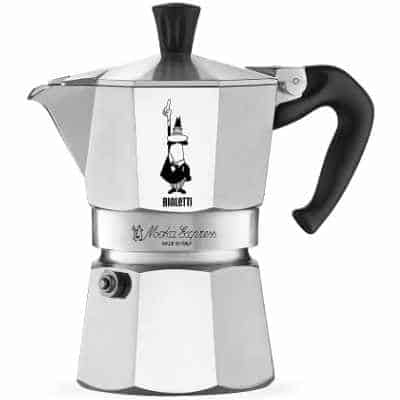
- It’s inexpensive
- It heats directly on the stovetop
- Capable of 1.5 bars of pressure
- Crema!
So how do we get that espresso-like drink using a Moka pot?
Step 1: Fill with water
Fill the lower chamber of your Moka pot with water. Many coffee experts suggest starting your pot with warm water. This saves your grounds from starting to cook while your water warms up, and prevents your drink from becoming bitter. The water level should reach just below the safety valve.
Step 2: Add coffee
Set up the filter basket with 15-17 grams of fine to medium-fine grounds (or until your filter is full). For espresso, you would tamp the grounds with a tamper, but for a Moka pot, you don’t want the grounds super packed. You can just slide off the excess and gently press down the grounds with a finger or spoon.
Step 3: Use Medium Heat
You will want to brew your coffee on medium heat, which is hot enough to get things going, but not so hot that it burns your coffee.
Step 4: Watch Your Pot
While we’ve always heard that “a watched pot never boils,” in this instance, you actually want to watch your pot. One reason is that you don’t want your pot to boil, and, also, you need to pull it off right when it’s done.
A Moka pot can be difficult to master. At the beginning of my relationship with this pot I sometimes I was rewarded with a great brew for my efforts, but many times my coffee just came out tasting burned and bitter. One hack I learned from studying up on the process, is that the lid can actually be left up to keep a better eye on what is going on. While the control freak in me had been tempted to try this, I had always left the lid down because I thought that’s what lids were for, and I try to follow the rules.
Step 5: Cool it Down
When you watch your brew, if you see your coffee is spurting up, it means you should turn your heat down. If your coffee is just coming up now and then, turn the heat up a bit. At an ideal heat, you should see a steady stream of bubbly coffee spilling over the funnel. When it is done, pull it immediately off the heat. Some experts even suggest running water over the bottom of the pot to stop the coffee from continuing to cook.
The Moka pot can be tricky to handle, but if you learn its quirks, you will be rewarded with a flavorful, espresso-like brew.
The AeroPress Brewing Method
The AeroPress is a newbie in the playing field but has had a great amount of success in its relatively short lifetime. It was invented in 2005 by a coffee-lover and scientist whose goal was to make a perfect cup of coffee. The result was a brew that was similar to espresso in strength and smoothness and cuts down on the bitterness often found in the brew.
What we like about the AeroPress:
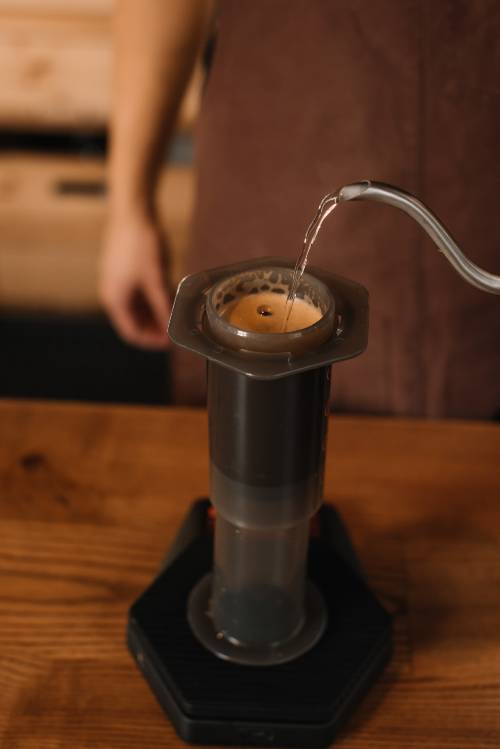
- It’s inexpensive
- It’s travel-friendly
- Capable of 0.35-0.75 bars of pressure
- Less bitterness
Step 1: Set Up Your Press
Set up your Aeropress and add a paper filter to the drain cap. To slow the flow of water, even more, you can use 2 filters. Wet the filter first for the cleanest taste.
Step 2: Grind Your Coffee to Table Salt Consistency
Grind your coffee to the consistency of table salt and add about 2 Tbsps to the filter. If you are trying for an espresso-like cup, it will be better to err on the side of more grounds when measuring them out. When your Aeropress is set up, place it over your favorite coffee mug.
Step 3: Heat the Water
For the best AeroPress coffee, you want your water to be hot but not boiling. Heat 3 1/2 oz of water to about 200 degrees, pour into your Aeropress, and stir the grounds.
Step 4: Press It Down
Press down hard on the plunger to extract the brew. Try to use as much force as possible. It may or may not accomplish a significant difference in the process, but you will know that you are doing your all to create as much pressure as possible for the perfect shot.
The Aeropress can be off-putting before you get to know it well. It carries an air of complicated mysteriousness and, at first, you feel like maybe you need to be a scientist to try it. But once you do build up the courage to try this method, it’s not as daunting as it first seems.
The result of your efforts is a rich, smooth brew that is less bitter than many other methods. It is definitely worth it to give the Aeropress a shot!
French Press Brewing Method
Making a home espresso with a French press is a little like when you play “telephone” and the message begins to get muddled after the 3rd or 4th person, but still retains some of the original message.
The French press is not a quick brew method and does not use any measurable amount of pressure. It is getting farther from an espresso than the Moka pot or Aeropress, but will still be closer in taste to espresso than other methods like drip coffee or pour-over.
What we like about the French press:
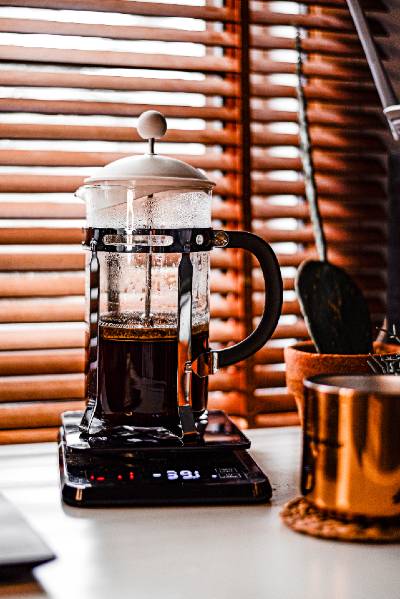
- It’s inexpensive
- Concentrated brew
- Clean flavor
To make a good coffee with your French press, you need to carefully pay attention to your time and temperature.
Step 1: Medium to Coarse Coffee Grind
Grind your coffee beans to a medium to coarse grind and get ready a kettle of hot water. You will want to pull the kettle before the water temperature reaches the boiling point (or, at about 200 degrees).
Step 2: Bloom the Coffee
Add the grounds to the bottom of your French press and pour just enough hot water over the grounds for the coffee to “bloom.” Then add the rest of the water and cover with its lid. Stir the grounds to make sure you are getting an even extraction.
Step 3: Set a Timer and Press
Set a timer for 4 minutes. When it is done, press down the coffee carefully and smoothly to make sure that the strainer stays in place to keep the grounds out of your drink.
You won’t really see any crema or froth with this brew method. Still, the French press can give you a concentrated clean-tasting brew. Also, since the brewing process is slower you can begin to taste more of the coffee bean’s notes and nuances.
French press coffee is a timeless classic and a great-tasting brew. In a pinch, it can scratch the itch of your espresso need.
The Semi-Automatic Espresso Machine
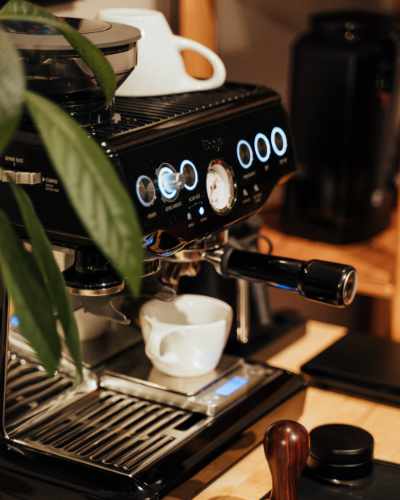
Ah, yes, finally a home espresso with true crema on top. The semi-automatic espresso machine is made for home users and is able to extract a shot of espresso using 9 bars of pressure.
Check carefully before investing in your machine, though, as some more inexpensive models will only get you to 1.5-3 bars of pressure. The semi-automatic does most of the work for you but still gives you some control over your brew by allowing you to choose when to cut off the shot. You can find some solid semi-automatic espresso machines on Amazon that are not much more expensive than your average drip coffee maker.
What we like about the semi-automatic espresso machine:
- Capable of 9+ bars of pressure
- Control over your shot
- Crema
Step 1: Choose Your Beans and Use a Fine Grind
Since brewing espresso is a fast brewing process, you will want to use a fine grind. This allows you to extract as much flavor out of the beans as possible. Freshly ground beans will keep more of the oils in your coffee, which will give you that rich flavor you’ve been searching for.
A burr coffee grinder will allow you to select a fine grind, whereas a blade grinder will not be your friend here.
Fresh coffee beans from a local roaster will always be a sure-fire way to find some excellent beans. Roast coffee beans that are particularly good for espresso can go by several names: French Roast, Italian Roast, and even simply Espresso Beans are among many of the names. All-in-all, if it’s a dark roast, you can be confident you’ll get a lovely crema from those beans.
Step 2: Add Coffee to the Portafilter
Measure out 1 Tbsp of coffee for a single shot or 2 Tbsp for a double shot of espresso. This works out around 6 grams of coffee for a single shot and 12 grams of coffee for a double shot.
You will want to tamp down the grounds in the portafilter for an even extraction coffee. Tamping the coffee helps to ensure you get the pressure right.
Step 3: Pull Your Shot
Set a demitasse under each spout and lock the portafilter into the group head. Use the machine’s lever or button to send the pressurized water through your grounds. After the pump starts, most experts recommend a 25-30 sec time range. To make the perfect shot, you can use a timer to find the right moment to cut off your machine.
The amount of coffee per shot that you’re aiming for is usually around 1 Ounce.
Step 4: Watch the Brew
After you’ve started your machine, stay and watch the brew for quality control and to know how to make adjustments in the future to get the best espresso. Since this method finishes in a matter of seconds, there is really nothing better to do with your time, anyway! If you notice that your brew is dark and slow, you should try using a slightly larger grind size. If your brew is light and fast, your brew is under-extracted and you can try a finer grind.
The semi-automatic espresso machine is a great way to get the espresso you are looking for without spending 1000s of dollars. While this machine might not grind your beans or have a double boiler, like a fully automatic or super-automatic machine, it can pull a good shot at 9+ bars. This machine gives you some control over your espresso taste by allowing you to “call the shot” and cut off the water flow when you consider that your espresso is ready.
Final thoughts
Whether you enjoy sipping and savoring it in European style or using it as a base for lattes and cappuccinos, there is nothing better than a good espresso! Even without a fancy espresso machine, you can still make a pretty good cup of coffee with the brewing methods we mentioned above.
The French press is a good choice for a simple method with a concentrated flavor, while the Moka Pot and the AeroPress will even give you a bit of crema on top! These home espresso hacks are definitely worth a try.
For an authentic espresso that uses 9+ bars of pressure, you can try a semi-automatic espresso machine. If all else fails, there is always the barista at your local coffee shop who can make authentic espressos and serve you your favorite drink.



